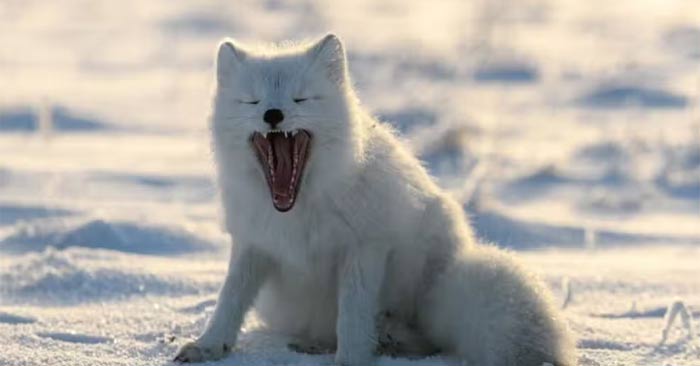Facts about Arctic foxes you may not know
Arctic foxes are known to form lifelong bonds, staying with one mate for their entire lives. What could be more interesting than that? Here are some surprising facts about Arctic foxes.

The Arctic fox is one of the most beautiful animals in the world. Its thick, snow-white fur and piercing black eyes are its two most striking features. These small predators are incredibly resilient. The icy, snow-covered regions of the far northern hemisphere where they live are not exactly the most pleasant places by any standards.
However, Arctic foxes don't just survive the cold; they thrive in it! Now let's explore what makes Arctic foxes so extraordinary, beyond their undeniably adorable appearance.
The Arctic fox is the only land mammal native to Iceland.
Arctic foxes have lived in Iceland long before humans arrived. Scientists believe they arrived about 10,000 years ago during the Ice Age. During this period, an ice bridge formed, connecting Iceland to neighboring regions such as Russia, Greenland, and North America. This allowed Arctic foxes to migrate to the small island.

They are "designed" to withstand cold weather.
Arctic foxes live in one of the coldest places on earth, the Arctic. This area can experience winter temperatures as low as −65 degrees Fahrenheit (−54 degrees Celsius).
But the frigid Arctic weather is no match for these foxes; they are so good at dealing with the cold that they don't even need to hibernate!
Their small round bodies, short limbs and small ears help prevent unnecessary heat loss.
They also have thick, waterproof fur and a fluffy tail, which they sometimes wrap around themselves like a winter scarf.
These adaptations allow the Arctic fox to withstand extreme temperatures, only starting to shiver when it drops below −94 °F (−70 °C)!
Arctic foxes have fur that can change color.
The Arctic fox's bright white fur helps it blend in perfectly with the snowy landscape in the winter. But come summer, you won't see white foxes. That's because they shed their white fur for a grayish-brown coat around June.
This new coat is thinner, more breathable, and better suited to warmer weather. It also blends better with the landscape as the ice melts.

Arctic foxes are extremely loyal.
The courtship season of Arctic foxes typically begins two months before the end of winter and is a lively affair. Single foxes chase each other and engage in playful fights before eventually forming pairs.
But it's not just during the breeding season; they stick together long after, working together as a team to raise and forage for their young.
They can smell food from miles away.
Food can sometimes be scarce in the Arctic. Luckily, the Arctic fox's keen sense of smell gives it an advantage. If there is a seal den within a mile, they can smell it, especially if there are small pups to hunt.
They are also scavengers, so they use this keen sense of smell to sniff out animal carcasses from over 20 miles (32 km) away.
You should read it
- Mini ozone hole opens over Arctic and, yes, that's kinda weird
- GitHub bury its entire repository under the North Pole to prevent the apocalypse happening
- Top 4 strange animals that change color to white in winter
- 11 interesting differences between the two ends of the Earth: Arctic and Antarctica
- Acid in the Arctic Ocean increases rapidly with climate change
- Dell added White Studio XPS
- The mystery behind the self-fuming hills for centuries
- Things you may not know about reindeer
- 8 most beautiful nature photos of November voted by National Geographic
- The weirdest place on the planet: Where the compass points in one direction and more
- Sea water prevents the release of ancient methane
- Because of the Covid-19 epidemic, more than 100 scientists were trapped on icebreakers between the Arctic Ocean
May be interested

How to Use Technology to Overcome Procrastination

You'll Soon Be Able to Cross-Post WhatsApp Statuses to Facebook and Instagram

Why do many people think Spatial Audio is completely meaningless?

The 9 Biggest Problems with DALL-E

Surprising Fact: Tank Gun Barrel Lifespan Is Only 6 Seconds

How to Fix the Error of Watching Videos with Green Stripes Highly Effectively






 Top 4 strange animals that change color to white in winter
Top 4 strange animals that change color to white in winter Things you may not know about reindeer
Things you may not know about reindeer Unexpected story: Wild dogs and foxes recognize the same species, frolic like brothers
Unexpected story: Wild dogs and foxes recognize the same species, frolic like brothers 8 most beautiful nature photos of November voted by National Geographic
8 most beautiful nature photos of November voted by National Geographic Mini ozone hole opens over Arctic and, yes, that's kinda weird
Mini ozone hole opens over Arctic and, yes, that's kinda weird 9 discover interesting surprises about the animal world in 2016
9 discover interesting surprises about the animal world in 2016